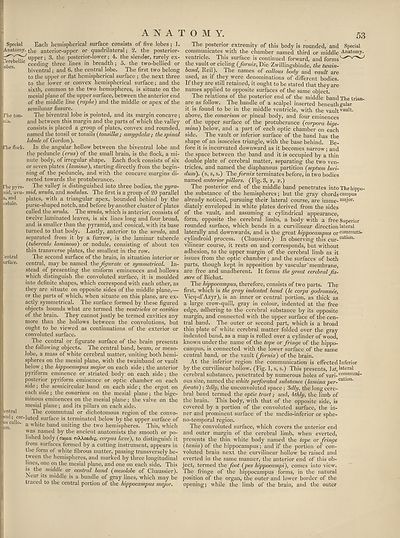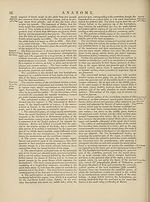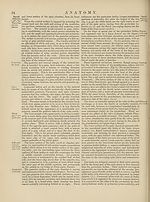Encyclopaedia Britannica > Volume 3, Anatomy-Astronomy
(61) Page 53
Download files
Complete book:
Individual page:
Thumbnail gallery: Grid view | List view

ANATOMY.
Special Each hemispherical surface consists of five lobes; 1.
Anatomy. t]ie anterior-upper or quadrilateral; 2. the posterior-
upper; 3. the posterior-lower; 4. the slender, rarely ex-
obes;1C ceeding three lines in breadth ; 5. the two-bellied or
biventral; and 6. the central lobe. The first two belong
to the upper or flat hemispherical surface ; the next three
to the lower or convex hemispherical surface; and the
sixth, common to the two hemispheres, is situate on the
mesial plane of the upper surface, between the anterior end
of the middle line (raphe) and the middle or apex of the
semilunar fissure.
/’he ton- The biventral lobe is pointed, and its margin concave;
sihs. and between this margin and the parts of which the valley
consists is placed a group of plates, convex and rounded,
named the tonsil or tonsils (tonsillce; amygdala; the spinal
lobule of Gordon).
The flock. In the angular hollow between the biventral lobe and
the peduncle (crus) of the small brain, is the flock, a mi¬
nute body, of irregular shape. Each flock consists of six
or seven plates (laminae), starting directly from the begin¬
ning of the peduncle, and with the concave margins di¬
rected towards the protuberance.
Phepyra- The valley is distinguished into three bodies, (he pyra-
nid, uvu- mid, uvula, and nodulus. The first is a group of 20 parallel
a, and plates, with a triangular apex, bounded behind by the
mdiile. purse-shaped notch, and before by another cluster of plates
called the uvula. The uvula, which is anterior, consists of
twelve laminated leaves, is six lines long and four broad,
and is smaller than the pyramid, and conical, with its base
turned to that body. Lastly, anterior to the uvula, and
separated from it by a furrow, is the laminar tubercle
(tuberculo laminoso) or nodule, consisting of about ten
thin transverse plates, the smallest in the row.
. 'cntral The second surface of the brain, in situation interior or
lurlace. central, may be named the jigurate or symmetrical. In¬
stead of presenting the uniform eminences and hollows
which distinguish the convoluted surface, it is moulded
into definite shapes, which correspond with each other, as
they are situate on opposite sides of the middle plane,—
or the parts of which, when situate on this plane, are ex¬
actly symmetrical. The surface formed by these figured
objects bounds what are termed the ventricles or cavities
of the brain. They cannot justly be termed cavities any
more than the hollows between the convolutions, but
ought to be viewed as continuations of the exterior or
convoluted surface.
The central or figurate surface of the brain presents
the following objects. The central band, beam, or meso-
lobe, a mass of white cerebral matter, uniting both hemi¬
spheres on the mesial plane, with the twainband or vault
below ; the hippocampus major on each side; the anterior
pyriform eminence or striated body on each side; the
posterior pyriform eminence or optic chamber on each
side; the semicircular band on each side; the ergot on
each side; the conarium on the mesial plane; the bige-
minous eminences on the mesial plane; the valve on the
mesial plane; and its pillars on each side,
entral Ihe commutual or dichotomous region of the convo-
iml ; cor-luted surface is terminated below by the upper surface of
u^c.1 o- a white band uniting the two hemispheres. This, which
vyas named by the ancient anatomists the smooth or po¬
lished body (aufia. nWoubn, corpus laeve), to distinguish it
from surfaces formed by a cutting instrument, appears in
the form of white fibrous matter, passing transversely be¬
tween the hemispheres, and marked by three longitudinal
lines, one on the mesial plane, and one on each side. This
is the middle or central band (mesolobe of Chaussier).
Near its middle is a bundle of gray lines, which may be
traced to the central portion of the hippocampus major.
The posterior extremity of this body is rounded, and Special
communicates with the chamber named third or middle Anatomy,
ventricle. This surface is continued forward, and forms
the vault or cieling (fornix, Die Zwillingsbinde, the twain-
band, Reil). The names of callous body and vault are
used, as if they were denominations of different bodies.
If they are still retained, it ought to be stated that they are
names applied to opposite surfaces of the same object.
The relations of the posterior end of the middle band The trian-
are as follow. The handle of a scalpel inserted beneath gular
it is found to be in the middle ventricle, with the vaultvault-
above, the conarium or pineal body, and four eminences
of the upper surface of the protuberance (corpora bige-
mina) below, and a part of each optic chamber on each
side. The vault or inferior surface of the band has the
shape of an isosceles triangle, with the base behind. Be¬
fore it is incurvated downward as it becomes narrow; and
the space between the band and it is occupied by a thin
double plate of cerebral matter, separating the two ven¬
tricles, and named the diaphanous partition (septum luci-
dum). (s, s, s.) The fornix terminates before, in two bodies
named anterior pillars. (Fig. 3, f, f.)
The posterior end of the middle band penetrates into The hippo-
the substance of the hemispheres; but the gray chords campus
already noticed, pursuing their lateral course, are imme-ma.ior-
diately enveloped in white plates derived from the sides
of the vault, and assuming a cylindrical appearance,
form, opposite the cerebral limbs, a body with a free Superior
rounded surface, which bends in a curvilinear direction lateral
laterally and downwards, and is the great hippocampus orco™muni-
cylindroid process. (Chaussier.) In observing this cur-catlon'
vilinear course, it rests on and corresponds, but without
adhesion, to the upper margin of the cerebral limb as it
issues from the optic chamber; and the surfaces of both
parts, though kept in apposition by vascular'membrane,
are free and unadherent. It forms the great cerebral fis¬
sure of Bichat.
The hippocampus, therefore, consists of two parts. The
first, which is the gray indented band (le corps godronnee,
Vicq-d’Azyr), is an inner or central portion, as thick as
a large crow-quill, gray in colour, indented at the free
edge, adhering to the cerebral substance by its opposite
margin, and connected with the upper surface of the cen¬
tral band. The outer or second part, which is a broad
thin plate of white cerebral matter folded over the gray
indented band, as a map is rolled over a cylinder of wood,
known under the name of the tape or fringe of the hippo¬
campus, is connected with the lower surface of the same
central band, or the vault (fornix) of the brain.
At the inferior region the communication is effected Inferior
by the curvilinear hollow. (Fig. 1, s, s.) This presents, ] st, lateral
cerebral substance, penetrated by numerous holes of vari-con?rmmi*
ous size, named the white perforated substance (lamina p>er-catlon-
forata) ; 2dly, the unconvoluted space ; Mly, the long cere¬
bral band termed the optic tract; and, Uhly, the limb of
the brain. This body, with that of the opposite side, is
covered by a portion of the convoluted surface, the in¬
ner and prominent surface of the medio-inferior or sphe-
no-temporal region.
The convoluted surface, which covers the anterior end
and outer margin of the cerebral limb, when everted,
presents the thin white body named the tape or fringe
(tcenia) of the hippocampus; and if the portion of con¬
voluted brain next the curvilinear hollow be raised and
everted in the same manner, the anterior end of this ob¬
ject, termed the foot (pes hippocampi), comes into view.
The fringe of the hippocampus forms, in the natural
position of the organ, the outer and lower border of the
opening; while the limb of the brain, and the outer
Special Each hemispherical surface consists of five lobes; 1.
Anatomy. t]ie anterior-upper or quadrilateral; 2. the posterior-
upper; 3. the posterior-lower; 4. the slender, rarely ex-
obes;1C ceeding three lines in breadth ; 5. the two-bellied or
biventral; and 6. the central lobe. The first two belong
to the upper or flat hemispherical surface ; the next three
to the lower or convex hemispherical surface; and the
sixth, common to the two hemispheres, is situate on the
mesial plane of the upper surface, between the anterior end
of the middle line (raphe) and the middle or apex of the
semilunar fissure.
/’he ton- The biventral lobe is pointed, and its margin concave;
sihs. and between this margin and the parts of which the valley
consists is placed a group of plates, convex and rounded,
named the tonsil or tonsils (tonsillce; amygdala; the spinal
lobule of Gordon).
The flock. In the angular hollow between the biventral lobe and
the peduncle (crus) of the small brain, is the flock, a mi¬
nute body, of irregular shape. Each flock consists of six
or seven plates (laminae), starting directly from the begin¬
ning of the peduncle, and with the concave margins di¬
rected towards the protuberance.
Phepyra- The valley is distinguished into three bodies, (he pyra-
nid, uvu- mid, uvula, and nodulus. The first is a group of 20 parallel
a, and plates, with a triangular apex, bounded behind by the
mdiile. purse-shaped notch, and before by another cluster of plates
called the uvula. The uvula, which is anterior, consists of
twelve laminated leaves, is six lines long and four broad,
and is smaller than the pyramid, and conical, with its base
turned to that body. Lastly, anterior to the uvula, and
separated from it by a furrow, is the laminar tubercle
(tuberculo laminoso) or nodule, consisting of about ten
thin transverse plates, the smallest in the row.
. 'cntral The second surface of the brain, in situation interior or
lurlace. central, may be named the jigurate or symmetrical. In¬
stead of presenting the uniform eminences and hollows
which distinguish the convoluted surface, it is moulded
into definite shapes, which correspond with each other, as
they are situate on opposite sides of the middle plane,—
or the parts of which, when situate on this plane, are ex¬
actly symmetrical. The surface formed by these figured
objects bounds what are termed the ventricles or cavities
of the brain. They cannot justly be termed cavities any
more than the hollows between the convolutions, but
ought to be viewed as continuations of the exterior or
convoluted surface.
The central or figurate surface of the brain presents
the following objects. The central band, beam, or meso-
lobe, a mass of white cerebral matter, uniting both hemi¬
spheres on the mesial plane, with the twainband or vault
below ; the hippocampus major on each side; the anterior
pyriform eminence or striated body on each side; the
posterior pyriform eminence or optic chamber on each
side; the semicircular band on each side; the ergot on
each side; the conarium on the mesial plane; the bige-
minous eminences on the mesial plane; the valve on the
mesial plane; and its pillars on each side,
entral Ihe commutual or dichotomous region of the convo-
iml ; cor-luted surface is terminated below by the upper surface of
u^c.1 o- a white band uniting the two hemispheres. This, which
vyas named by the ancient anatomists the smooth or po¬
lished body (aufia. nWoubn, corpus laeve), to distinguish it
from surfaces formed by a cutting instrument, appears in
the form of white fibrous matter, passing transversely be¬
tween the hemispheres, and marked by three longitudinal
lines, one on the mesial plane, and one on each side. This
is the middle or central band (mesolobe of Chaussier).
Near its middle is a bundle of gray lines, which may be
traced to the central portion of the hippocampus major.
The posterior extremity of this body is rounded, and Special
communicates with the chamber named third or middle Anatomy,
ventricle. This surface is continued forward, and forms
the vault or cieling (fornix, Die Zwillingsbinde, the twain-
band, Reil). The names of callous body and vault are
used, as if they were denominations of different bodies.
If they are still retained, it ought to be stated that they are
names applied to opposite surfaces of the same object.
The relations of the posterior end of the middle band The trian-
are as follow. The handle of a scalpel inserted beneath gular
it is found to be in the middle ventricle, with the vaultvault-
above, the conarium or pineal body, and four eminences
of the upper surface of the protuberance (corpora bige-
mina) below, and a part of each optic chamber on each
side. The vault or inferior surface of the band has the
shape of an isosceles triangle, with the base behind. Be¬
fore it is incurvated downward as it becomes narrow; and
the space between the band and it is occupied by a thin
double plate of cerebral matter, separating the two ven¬
tricles, and named the diaphanous partition (septum luci-
dum). (s, s, s.) The fornix terminates before, in two bodies
named anterior pillars. (Fig. 3, f, f.)
The posterior end of the middle band penetrates into The hippo-
the substance of the hemispheres; but the gray chords campus
already noticed, pursuing their lateral course, are imme-ma.ior-
diately enveloped in white plates derived from the sides
of the vault, and assuming a cylindrical appearance,
form, opposite the cerebral limbs, a body with a free Superior
rounded surface, which bends in a curvilinear direction lateral
laterally and downwards, and is the great hippocampus orco™muni-
cylindroid process. (Chaussier.) In observing this cur-catlon'
vilinear course, it rests on and corresponds, but without
adhesion, to the upper margin of the cerebral limb as it
issues from the optic chamber; and the surfaces of both
parts, though kept in apposition by vascular'membrane,
are free and unadherent. It forms the great cerebral fis¬
sure of Bichat.
The hippocampus, therefore, consists of two parts. The
first, which is the gray indented band (le corps godronnee,
Vicq-d’Azyr), is an inner or central portion, as thick as
a large crow-quill, gray in colour, indented at the free
edge, adhering to the cerebral substance by its opposite
margin, and connected with the upper surface of the cen¬
tral band. The outer or second part, which is a broad
thin plate of white cerebral matter folded over the gray
indented band, as a map is rolled over a cylinder of wood,
known under the name of the tape or fringe of the hippo¬
campus, is connected with the lower surface of the same
central band, or the vault (fornix) of the brain.
At the inferior region the communication is effected Inferior
by the curvilinear hollow. (Fig. 1, s, s.) This presents, ] st, lateral
cerebral substance, penetrated by numerous holes of vari-con?rmmi*
ous size, named the white perforated substance (lamina p>er-catlon-
forata) ; 2dly, the unconvoluted space ; Mly, the long cere¬
bral band termed the optic tract; and, Uhly, the limb of
the brain. This body, with that of the opposite side, is
covered by a portion of the convoluted surface, the in¬
ner and prominent surface of the medio-inferior or sphe-
no-temporal region.
The convoluted surface, which covers the anterior end
and outer margin of the cerebral limb, when everted,
presents the thin white body named the tape or fringe
(tcenia) of the hippocampus; and if the portion of con¬
voluted brain next the curvilinear hollow be raised and
everted in the same manner, the anterior end of this ob¬
ject, termed the foot (pes hippocampi), comes into view.
The fringe of the hippocampus forms, in the natural
position of the organ, the outer and lower border of the
opening; while the limb of the brain, and the outer
Set display mode to:
![]() Universal Viewer |
Universal Viewer | ![]() Mirador |
Large image | Transcription
Mirador |
Large image | Transcription
Images and transcriptions on this page, including medium image downloads, may be used under the Creative Commons Attribution 4.0 International Licence unless otherwise stated. ![]()
| Encyclopaedia Britannica > Encyclopaedia Britannica > Volume 3, Anatomy-Astronomy > (61) Page 53 |
|---|
| Permanent URL | https://digital.nls.uk/193758141 |
|---|
| Attribution and copyright: |
|
|---|---|
| Shelfmark | EB.16 |
|---|---|
| Description | Ten editions of 'Encyclopaedia Britannica', issued from 1768-1903, in 231 volumes. Originally issued in 100 weekly parts (3 volumes) between 1768 and 1771 by publishers: Colin Macfarquhar and Andrew Bell (Edinburgh); editor: William Smellie: engraver: Andrew Bell. Expanded editions in the 19th century featured more volumes and contributions from leading experts in their fields. Managed and published in Edinburgh up to the 9th edition (25 volumes, from 1875-1889); the 10th edition (1902-1903) re-issued the 9th edition, with 11 supplementary volumes. |
|---|---|
| Additional NLS resources: |
|

